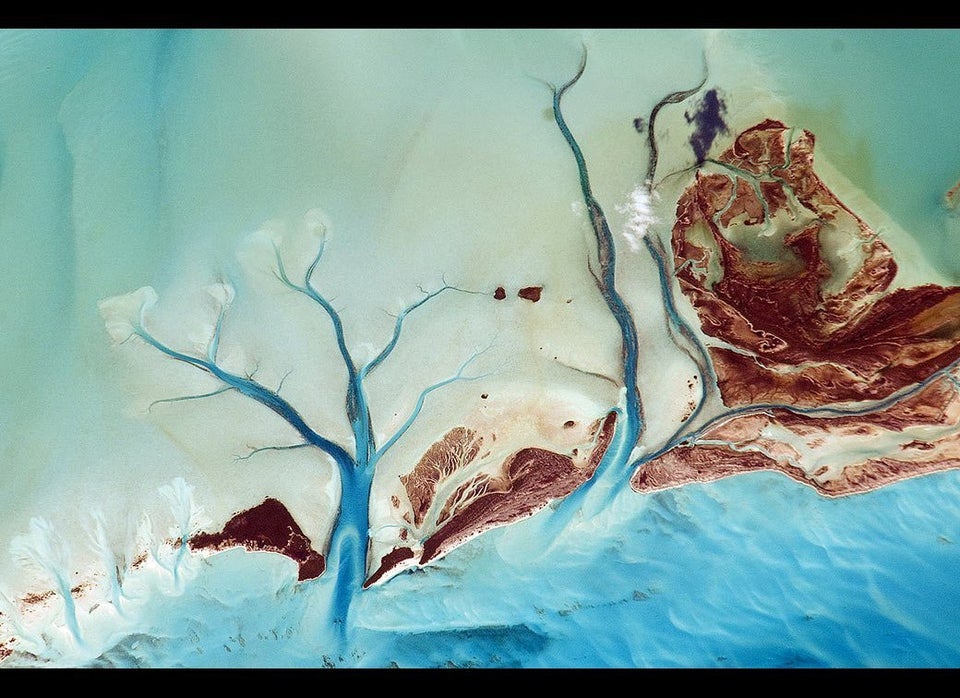An ancient, underwater forest off the coast of Alabama — hidden until recently by Mother Nature — is on track to become the second U.S. marine sanctuary in the Gulf of Mexico.
The Gulf of Mexico Fishery Management Council voted unanimously this month to support the forest's designation as a federal marine sanctuary, and to send a letter expressing that support to the National Oceanic and Atmospheric Administration (NOAA). Sanctuary status would still allow fishing and diving, but it would forbid disturbing the forest itself.
Ben Raines, executive director of the Weeks Bay Foundation, has been a leading advocate for saving the forest since he first saw it in 2012. After successfully pushing the council to support his efforts, he says he's optimistic NOAA will agree the forest warrants protection.
"This is a great step toward protecting the forest," Raines tells the Mobile Press-Register. "With the approval of the Gulf Council, we can move ahead toward a final designation from NOAA's National Marine Sanctuaries program. ... The underwater forest really fits in with what the program tries to protect. We've had preliminary conversations with NOAA about the forest, and I believe the forest will meet the criteria for the sanctuary designation."
The forest has been there for at least 50,000 years, hailing from an era with much lower sea levels. It was buried in seabed mud until 2005, when Hurricane Katrina dredged up its sprawling time capsule of cypress trees. This exposed new habitat for marine life, which eventually led fishermen and divers to the forest. The location remained secret for years, fueled by fears people might damage the trees or harvest their wood. Ocean sediments have preserved the cypress so well it reportedly still smells like fresh sap when cut.
"There is nothing else like it in the Gulf, and diving there really feels like you are exploring a lost world. To know these trees, covered in anemones and crabs, were growing on dry land tens of thousands of years ago, it sort of gives you chills," Raines tells the Press-Register, noting the area now teems with sharks, rays, red snapper and Kemp's ridley sea turtles. "We don't have large coral reefs around here like you see in the Florida Keys or the Caribbean, but those places don't have ancient trees popping up out of the bottom."
Now that they're no longer sealed in sand, the trees will eventually be destroyed by waves and wildlife (unless another storm reburies them first). But Raines says the habitat is worth protecting until it naturally decays, and he disputes the idea it's rotting quickly. "The stumps have been exposed about 10 years now and are still quite stout," he says. "I imagine we're talking about another decade easily before the wood that is presently exposed begins to really deteriorate. More importantly, more wood will continue to be exposed out there. I have sawed the wood underwater and on land, and attempted to drill cores out of it. Trust me, it's still every bit as hard as a fresh-cut piece of cypress." NOAA manages 14 national marine sanctuaries that span more than 170,000 square miles. The
, a network of coral reefs off Texas and Louisiana, is currently the only one located in the Gulf of Mexico. The next closest,
, is several hundred miles to the southeast in the Straits of Florida.
Support HuffPost
Our 2024 Coverage Needs You
Your Loyalty Means The World To Us
At HuffPost, we believe that everyone needs high-quality journalism, but we understand that not everyone can afford to pay for expensive news subscriptions. That is why we are committed to providing deeply reported, carefully fact-checked news that is freely accessible to everyone.
Whether you come to HuffPost for updates on the 2024 presidential race, hard-hitting investigations into critical issues facing our country today, or trending stories that make you laugh, we appreciate you. The truth is, news costs money to produce, and we are proud that we have never put our stories behind an expensive paywall.
Would you join us to help keep our stories free for all? Your contribution of as little as $2 will go a long way.
Can't afford to donate? Support HuffPost by creating a free account and log in while you read.
As Americans head to the polls in 2024, the very future of our country is at stake. At HuffPost, we believe that a free press is critical to creating well-informed voters. That's why our journalism is free for everyone, even though other newsrooms retreat behind expensive paywalls.
Our journalists will continue to cover the twists and turns during this historic presidential election. With your help, we'll bring you hard-hitting investigations, well-researched analysis and timely takes you can't find elsewhere. Reporting in this current political climate is a responsibility we do not take lightly, and we thank you for your support.
Contribute as little as $2 to keep our news free for all.
Can't afford to donate? Support HuffPost by creating a free account and log in while you read.
Dear HuffPost Reader
Thank you for your past contribution to HuffPost. We are sincerely grateful for readers like you who help us ensure that we can keep our journalism free for everyone.
The stakes are high this year, and our 2024 coverage could use continued support. Would you consider becoming a regular HuffPost contributor?
Dear HuffPost Reader
Thank you for your past contribution to HuffPost. We are sincerely grateful for readers like you who help us ensure that we can keep our journalism free for everyone.
The stakes are high this year, and our 2024 coverage could use continued support. If circumstances have changed since you last contributed, we hope you’ll consider contributing to HuffPost once more.
Already contributed? Log in to hide these messages.

